|
|
 |
|
 Meeting 1 Meeting 1
Note: In canvas 1994-014, the first in line of development, the green square is placed in central position and so overlapping both individual domains to visualize a shared interest and departure, a collective memory. This can also be seen in canvas 1994-033 that marks the beginning of the series with Joseph Semah. Works where made on the floor at studio Lauriergracht, Amsterdam. The green paint had been found along the street and had been used in several drawings before. According to their friend and colleague K (Jacobus Kloppenburg) this is a typical pré war common green that was used in many Amsterdam houses, to chase the depression away. Bien’s motives recall the recent travelling to South America with Kloppenburg: Energy loaded mountaintops, ritual architecture, landmark, an active interdisciplinary research station (laboratory), a primal head and, at canvas no6, the Bolivian alti Plano with bread glacier. There are lightly overleaping green brush strokes in canvas 3/4/6. In 3 there is a first notion of the later sculpture Mount Anvil that would be produced from copper and bronze in1995, also in Houston. On 5 one can find Bien’s fingerprints in Grotfeldt’s indigo blue bathing face. This was by accident but Grotfeldt insisted that it should stay this way, as much for social as pictorial reasons; Permitting the other to be present on ones private land signals great comfort and confidence and indicates that one is from the beginning on involved in a conscious process of social sculpture in an open framework.
|
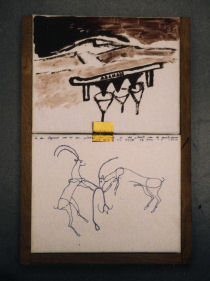
|
|
 Meeting 2 Meeting 2
Note: Works where executed in Grotfeldt’s studio Heights Blvd 1226, Houston, April 1995 where Bien at the same time was working for his upcoming show ‘Between the Ears’ at Diverse Works. For this he had reproduced some of the 1976 drawings of Raum 20 classmate Martin Schönenborn as part of a wall installation. In 1995-091 and 95 are traces of Schönenborn’s interdisciplinary journal. (FIU archive) Grotfeldt at the time was engaged in the healing plants series. His plants had by now been released from gravitational influence and appeared free floating in ‘open’ space. Works made with coal dust on river clay on canvas. Bien scratched Grotfeldt’s portrait 1995-057 ‘the Carbon Painter’ with his fingernails into the freshly prepared coal dust layer. After the opening at Diverse Works, with an opening speech by Luk Darras, the Belgian Consul General, the artists went to Mexico where they continued working, each for himself, but with corresponding iconography, even further reinforced by the shared medium (red Mexican soil from right under their feet) and paper. A hotel suite at Mexico City’s great plaza Zocalla, and the terrace of a villa in Puerto Escondido with outlook at the Pacific Ocean, became studio space. (Photo archive)
|
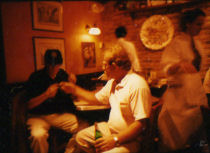
|
|
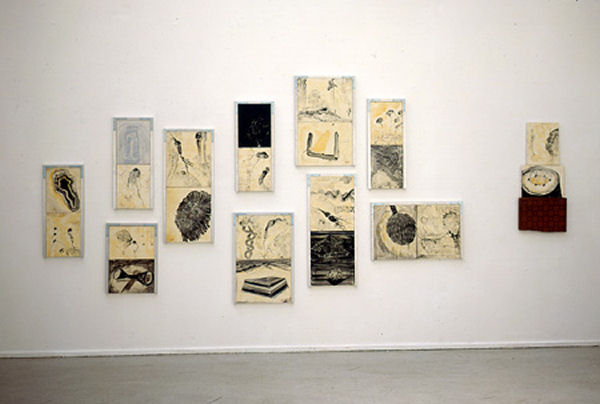 Meeting 3 Meeting 3
Amsterdam studio Lauriergracht. May/June 1996
Note: Canvasses in the size 30x40cm and 40x50cm, prepared with thin layers white river clay and worked on with coal dust from the Death Room Interior, having a black blue shine. To observe the drying layers of paint is a most inspiring occupation. The whole row was spread out on the studio floor and painted in a free flow over several days, without any set up correspondence. Afterwards combinations would be suggested and discussed, than fixed. The serial repetition of two canvasses, a dualistic intimate sphere, demanded transformation into a trinity, to indicate a broader social sculpture sphere. This was done with the help of a broken chessboard, found in the trash along the street. The most important argument for the chessboard choice is that it wasn’t a canvas and, as a game board, indicates open field and multiple choices. The determination of the object world (read’ canvas’) could so be shifted into a new dimension with sculptural thinking brought in sight to be analysed and taken into consideration, to become subject in a dialogue between a painter and a sculptor and who else would further participate in the future (Kloppenburg, 1997)
In double canvas1996-009, the short of perspective in the momentum is extended beyond our daily horizon by the fixation of the future date June 14, 2064, 68 years away from the moment it was written down, a black diamond figure underneath. In 1996-003 Bien closes the artichoke flower that Grotfeldt intended to open, with Grotfeldt similar brushstrokes.
In 1996-005, a chopped flint stone opposes Grotfeldt’s subtle morphological bio-energy, a natural harmony between Mineral and plant, point and counterpoint.
|

|
|
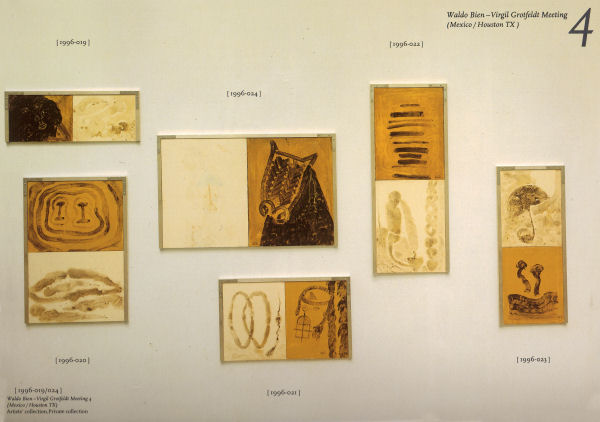 Meeting 4. Meeting 4.
Studio heights Blvd 1226, Houston. September 1996
Note: The yellow clay was brought back from Mexico. During this work session the paintings where made in direct response to one another. In 1996-022 Grotfeldt plants a screwing Brancusi like column and its continuing energy would screw into Bien’s canvas. This was countered with a resolute rhythm of brushstrokes. The 1996-024 left section (Grotfeldt) was considered a failure and he had already started to wash it over with white. Bien thought it finished and flanked it with the dark medieval Spanish bull. This combination was left than as it was. In 1996-021 ‘Wedding Rings’ by Grotfeldt and a Menorah by Bien, this in reference to the earlier series with Joseph Semah. The session was followed by a trip to Rio Grande, Mexico, “just kicking cans” (Grotfeldt) Samples of its brownish river clay was brought back for later use on canvas (meeting 8 and Bien’s further exploration in the series Seilschaften (notes on works, WB journal)
|
|
|
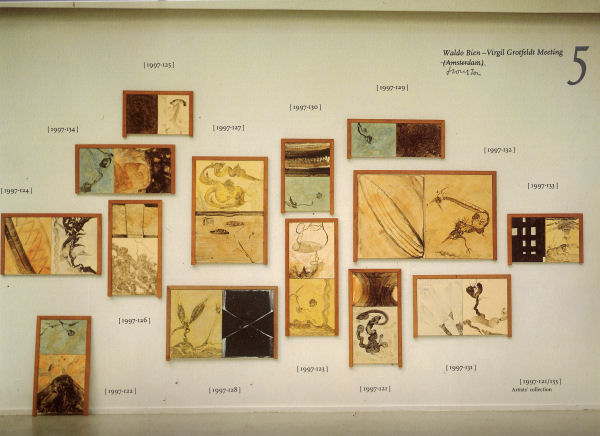 Meeting 5 Meeting 5
Studio Heights Blvd 1226, Houston. June/July 1997
Three large suitcases where bought at a second hand store. Than to Texas Art Supplies to fill them up with canvasses, 28 this time. Primed with river clay in the garden in humid weather and so plenty of time to observe the paint to dry. Grotfeldt introduces watercolour accents and chemo therapy (against his cancer, but traces can be found in the paintings as well) Lunches and dinners with Walter Hopps, his wife Caroline Huber and Deborah Grotfeldt, discussing the Kloppenburg affair and how to respond to it. Walter Hopps than writes his letter of support for the preservation of Kloppenburg’s Artchive for the Future www.artchiveforthefuture.com. Photo documentation shows this series on the studio wall in different stages and combinations. When ready installed, friends are invited for dinner and celebration.
Frame development (later, in Amsterdam); extending frame ends, asymmetrical (see also meeting 8) Wood: Tasmanian Nothofagus.
1997-129 is a portrait of Joseph Beuys with flower bud.
|
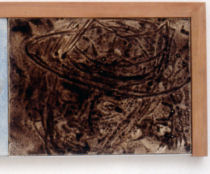 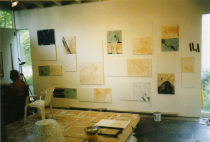
|
|
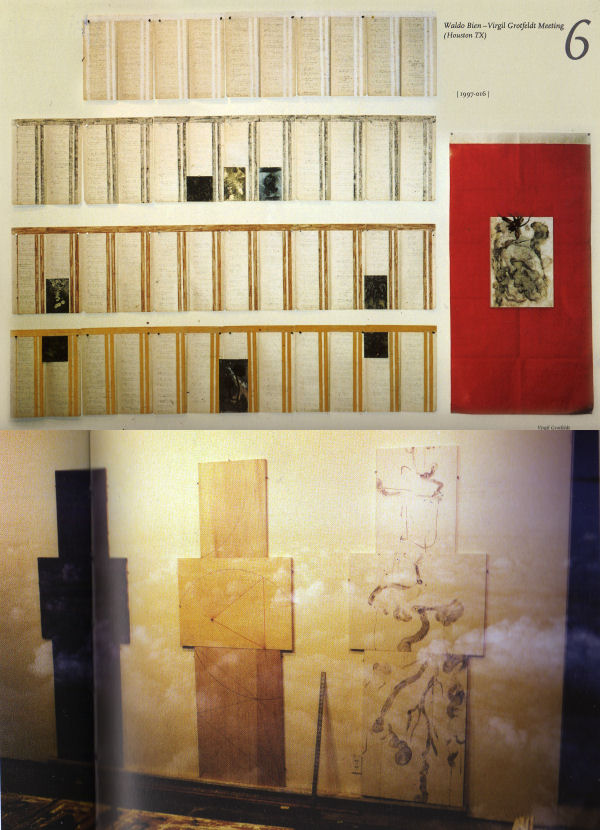 Meeting 6 Meeting 6
Studio Heights Blvd 1226, Houston. November 1997
Note; This session finds place right after the disastrous eviction of Kloppenburg’s Artchive for the Future by the Amsterdam City Council. Bien invited Kloppenburg to join him on his working visit to Grotfeldt in Houston.
First meeting was in New York, where they attended Grotfeldt’s exhibit at Jason McCoy gallery and where guests of Luk Darras, the Consul General of Belgium and his wife Barbara, at Fifth Avenue. In Houston; a meeting with Walter Hopps to report on the situation in Amsterdam. All where more or less exhausted from the past months. Grotfeldt also still under medication treatment. Nevertheless a series of small canvasses was bought and also 9 wooden drawing boards, made in Russia, in three different sizes. Grotfeldt had been working on ledger pages and several works where pinned against the studio wall. Bien had been reading ledger paper from an architectural point of view, as building with columns (see 1995-008), and started to further explore this with the use of some small Grotfeldt works on paper. If a painting would be considered to bad and be destroyed, Grotfeldt would cut out some acceptable sections in the size of a postcard that would later be used as invitation cards for a studio exhibit. This painterly extracts Bien now implanted into (not onto) the architectural concept of ledger paper. Not to decorate, but as gate/window or keyhole, giving aces to inner and outer dimensions like the door and window of the Temple, nowadays The Bank. Meanwhile the small canvasses where in progress and used by Bien/Grotfeldt as test field and note block for colours, brushstrokes and so on, creating a transparent strata of interdisciplinary research in a social sculpture process; see 1997-111. The 9 wooden drawing boards had been equally divided, 3 boards each. Grotfeldt laid on some brushstrokes with coal dust on gesso while Bien was using layers of dark brown clay and a staple gun, to cross mark certain points. Kloppenburg further explored the golden section with lead and colour pencil straight onto the wood. Photo documentation shows the series in several stages and combinations. Kloppenburg also took photographs that were double exposed on the flight back to Amsterdam, mixing Greenland clouds with the three cross work and the Grotfeldt studio in Houston. (LINK)
|
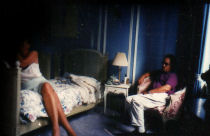
|
|
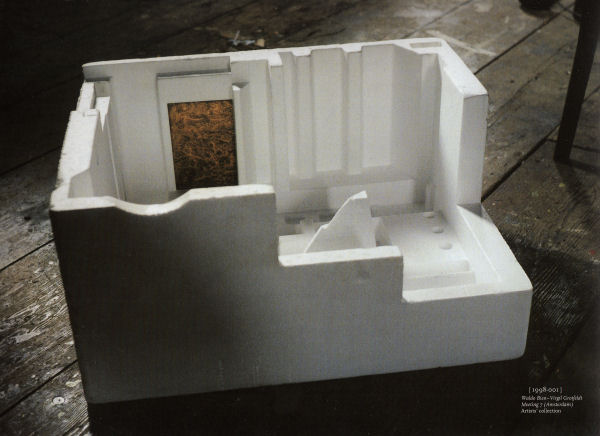 Meeting 7 Amsterdam/Houston, by telephone. Meeting 7 Amsterdam/Houston, by telephone.
Triggered by a look down out of the window of studio Lauriergracht (4th floor) onto trash gathered next to a tree and illuminated by a streetlight. The white Styrofoam packing worked as scale model of a mysterious space; Engine Room with fundaments for heavy machinery, but also reminding of Ritual Inca Architecture that had been seen in Bolivia and Peru. One of the left over Grotfeldt invitation cards (bronze powder on paper), mentioned in series 6 in Houston, was pinned into the Styrofoam box and straight away turned it into serious creative energy devoted space. This was discussed by telephone and fixed as meeting 7.
|

|
|
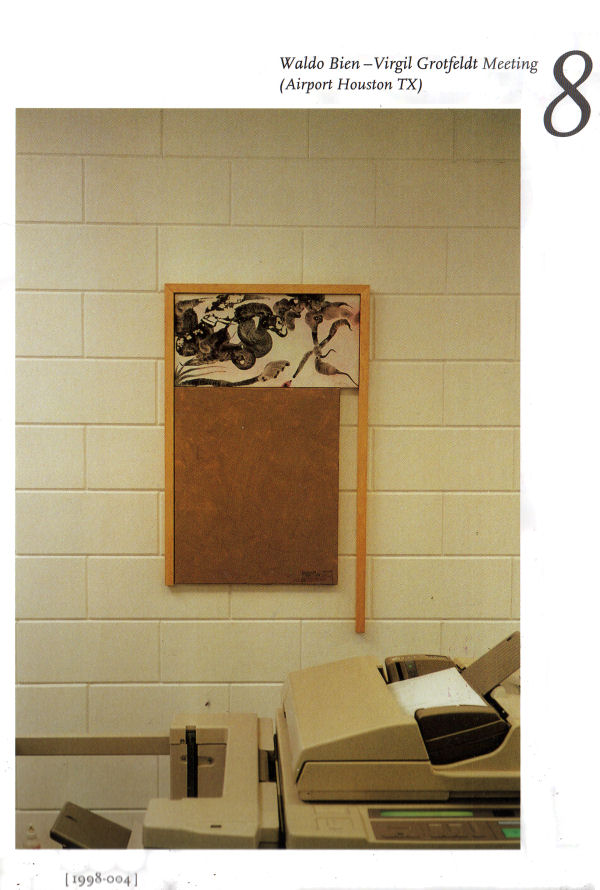 Meeting 8 came into existence at Airport Houston, 1998. Nothing was produced during this visit by general lack of energy. Grotfeldt had given Bien a canvas as a present and Bien suggested flanking it when back in Amsterdam with the first canvas he would make with the Rio Grande clay from their Mexico visit. In this case the canvasses had independent sizes, America versus European, what lead to this open and extended frame solution. Meeting 8 came into existence at Airport Houston, 1998. Nothing was produced during this visit by general lack of energy. Grotfeldt had given Bien a canvas as a present and Bien suggested flanking it when back in Amsterdam with the first canvas he would make with the Rio Grande clay from their Mexico visit. In this case the canvasses had independent sizes, America versus European, what lead to this open and extended frame solution.
|

|
|
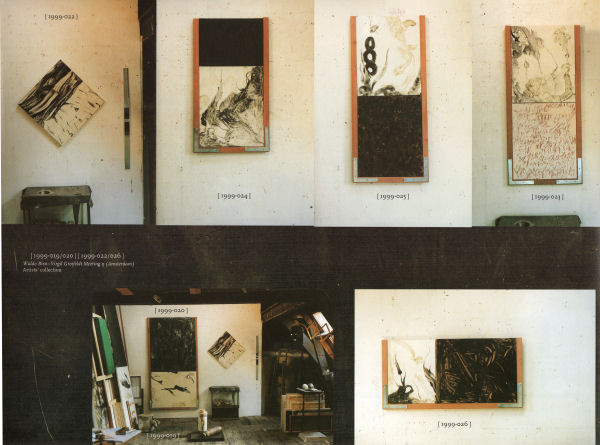 Meeting 9 Amsterdam 1999. Meeting 9 Amsterdam 1999.
Canvasses were prepared in advance with river clay in various layers. Grotfeldt had announced that he would arrive without energy left and also would bring his son Andy, an enthusiastic young painter, B feared that nothing would happen this time, but after several days of recovering first moves where made. The subjects B had worked on ultimately flowed into picture. Questioning the painting itself, as an optical suggestion on skin stretched over wood bones, a question that came up when visiting his 80-year-old mother and giving her a massage and seeing/feeling the skeleton underneath the skin.
For painters it’s bad news when after priming, the canvas shows stretcher bar imprints. This happens when a canvas is primed and drying lying on the floor. One of the things art students are told to avoid. In this case it became the issue itself, giving an idea how interdisciplinary research (in open frame) works. Some of the larger canvasses had stretcher bar marks after drying and so one could see the skeleton of the canvas. B, in the role of a sector in an anatomical research (as Rembrandt’s Doctor Tulip) suggested to cut the canvas and show what’s behind it. A rectangular cut was made, along the structure of the wood/skeleton, like butchers would do. Sections of two different paintings where taken (tissue samples, DNA) and reformed into a new, social sculptural dimension.
Frames where made after Grotfeldt had left, this time open at upper end. In 1999-022 B positioned a new element, photo on aluminium, next to the diagonal Grotfeldt canvas. This was was a lay of (or leftover) from his Kloppenburg portrait as Dutch Master and here as module, indicating a string of works that literally hang together. Frames made from evergreen beech wood from Tasmania.
|
 
|
|
 Meeting 10, June 1999 New York, Studio White Street Meeting 10, June 1999 New York, Studio White Street
At the same moment the FIUWAC was created in partnership with Triodos Bank. Bien had committed himself to fill half of the Triodos Building with FIUWAC artworks within only three months and the sum of 10.000 USD of his ‘own’ money that was created by his FIU loan given to Triodos Bank. There was no intention of working together by obvious lack of time. Grotfeldt worked for upcoming shows. Several new works where standing around. Bien came as FIUWAC founding director with the mission to acquire a series of Grotfeldt works for FIUWAC and invite him to contribute with donations. Bien bought the painting Dollar Green and straight away donated it to FIUWAC. To show that it was real Bien pulled out a stack of $100 bills and stabled them onto the wall as a frame, causing great laughter but afterwards the trouble that this had to be covered with a sheet every time the studio door had to be opened. Right next to it, at left, a collaborative work on ledger, the ledger Temple stocked up with a Grotfeldt coal dust drawing on Brail, now FIUWAC and installed in the conference room of Triodos Bank Zeist. Several others where started but left to be worked out. Two drawings on carbon paper from the fashion industry below where made on the rooftop, drinking beer and looking at the Gay parade firework in distanced Manhatten. 1999-053
|
 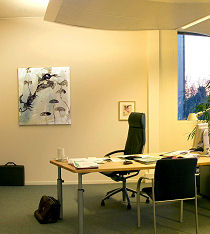
|
|
 Meeting 11. The End of Sorrow series, painted on X-rays. Meeting 11. The End of Sorrow series, painted on X-rays.
Note: Produced in Normandy, the FIU Summer school building. B had brought a bag with old X rays, found by Kloppenburg near a hospital in Düsseldorf, along with some house paint. Photo record of all stages of development and Grotfeldt brushstrokes exist. (FIU archive) When working on X Ray one should be aware that all pictorial quotations one makes, are placed into a living space, the human body as a universe.
|
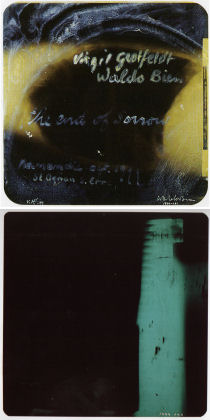 
|
|
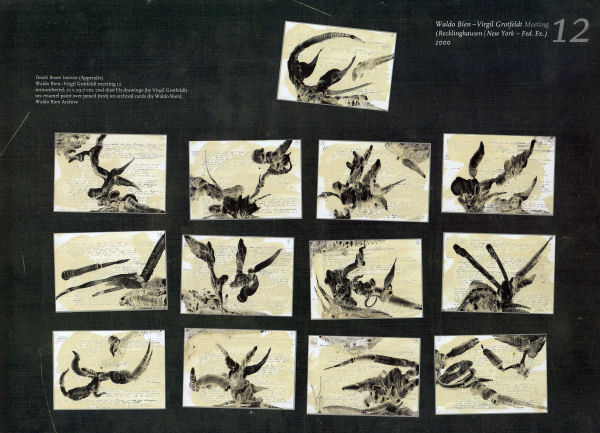 Meeting 12 2000, Recklinghausen/New York- Federal Express Meeting 12 2000, Recklinghausen/New York- Federal Express
Bien had asked Grotfeldt’s participation by the creation of an Appendix series for the Death Room Interior. B was working with Kunsthalle director Ferdinand Ullrich and Hans-Jürgen Schwalm, translating the Patrick Healy text into German for the upcoming publication. The rough translations in Bien’s handwriting on archival cards where white washed and send to NY where G sealed them off with additional notes and back to Germany with Fed. Ex and put in the open frames B meanwhile created, by painting as well on the outside as on the inside of the frame to avoid optical hierarchical levels and create an as open as possible sphere. Nearly all collaborative works where on show at the Kunsthalle Recklinghausen, grouped around the sculpture Death Room Interior, that brought all this into being. Also the triptych with Kloppenburg was involved.
|
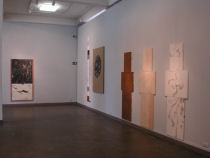 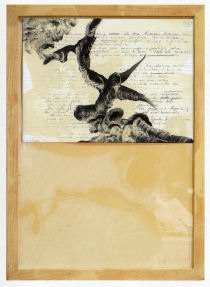
|
|
 Meeting 13. Houston/Dallas, 2001 Meeting 13. Houston/Dallas, 2001
Small and oval canvasses where bought, a special offer, and first rather autistic gestures had been made on them with mud and paint when they had to leaf for Dallas to attend the opening of Grotfeldt’s show at Pillsburry and Peters. There next to their bed the answer to a question Grotfeldt had raised in Normandy, noticing that every second village had something named after a woman named Charlotte Corday: be it bakers, cleaners, gas stations, drugstores etc. Charlotte Corday came from the Norman region Calvados, went to Paris and murdered Marat ,the French revolutionary and publisher of ‘l’amie du peuple’ in his bath tube. On a table in Dallas was an 1980 issue of ARTS magazine with an article on Charlotte Corday and the French Revolution, by Michael Marrinan: …”During the night an angry mob, demanding swift justice for the assassin, gathered in the street and blocked the stairway to the victims apartment. When the time came to move her to prison, the crowd’s anger flared violently, nearly preventing her safe removal from the scene. Charlotte Corday spent the 14th to the 16th of July (1793) in the Abbaye prison. From her cell she could hear the sounds of Marat’s triumphal funeral in the streets below. On the 17th, Corday faced the Revolutionary Tribunal. Although the extreme composure and firm resolution of the pretty Normandy maiden stunned the packed galleries of curious spectators into silence, she was nevertheless sentenced to death for her crime and executed that evening. As the fateful cart carried her trough the streets of Paris towards the Place de la Révolution, amid the jeers and insults of the enraged sans-culottes, Charlotte’s courage never once cracked. At a time when noble composure counted for much, this conduct had such a profound impact on the spectators that a general indignation swept the multitude when a zealous republican grabbed her severed head from the basket and slapped its cheeks. The journals of that day dedicated a generous amount of column space to Marat’s murder and woodcuts would frequently adorn their pages;
Marat is in his sabot-shaped tub, his head wrapped in a towel. A small round table with inkwell and paper upon is next to him. Charlotte Corday stands over her victim and strikes the vital blow, pushing the knife deep into the right side of Marrat’s upper chest. She wears the striped dress and tall hat that with wide brim that is recorded in the various eyewitness accounts.”
Back in Houston the series was than quickly finished and named ‘Flowers for Charlotte Corday’
|
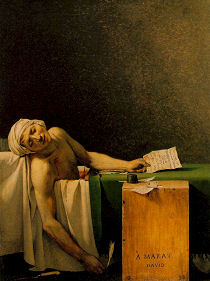 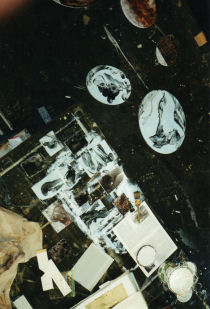 
|
|
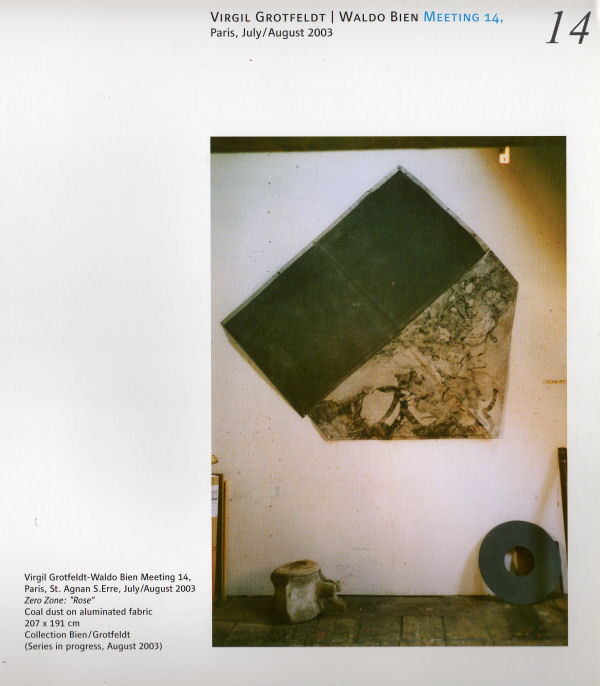 Meeting 14, Paris, July/August 2003 Meeting 14, Paris, July/August 2003
A rubber and aluminium coated fabric left behind by Piero Heliczer (LINK) after his death in 1995 (see FIU Summer school). Heliczer had used it to wrap baggage when crossing the roads of Normandy on motorbike. Grotfeldt tried some brushstrokes on it. Later it was cut in half because Grotfeldt preferred the aluminium coating and Bien the black back. B suggested to sew them back together with one section turned over and by doing so, eliminate the hierarchical front/back dilemma with a cubistic gesture and twisting back to front, like on canvas 1997-128 meeting 5. Beuys had dissolved this most effectively in a small two-sided drawing on note block paper made during the war in Russia, 1943 (Collection van der Grinten, Museum Schloss Moyland) on both sides picturing a female portrait. The pencil drawing from the ‘back’ is vaguely visible on the ‘front’ and vice versa. Beuys than brings them together in the title: Zwei Russinen (Two Russian women) Also: Kloppenburg’s artwork ‘The Elimination of Symmetry’ FIUWAC. And ultimately in the construction of the FIU Loan to Triodos Bank, 1999 (making the invisible visible).
|
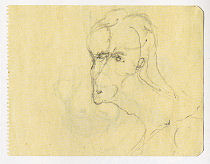 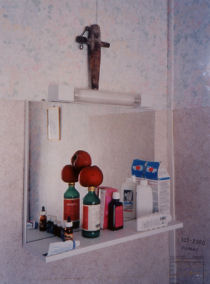
|
|
|
|
|